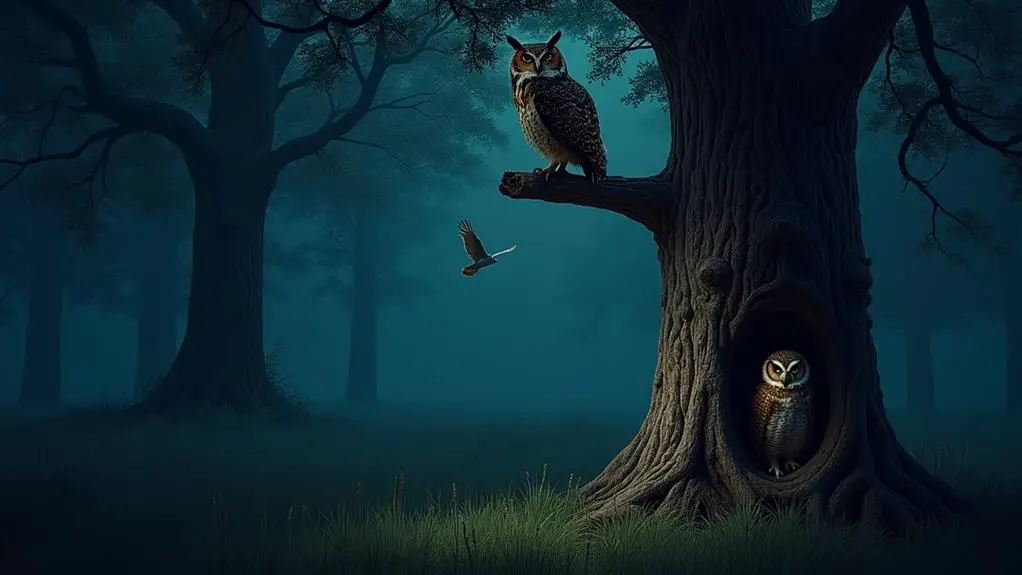If you’re walking through a Texas park at dusk, you might catch a glimpse of an Eastern Screech Owl perched in a tree, its large eyes scanning the ground for prey. As you watch this owl, you might wonder what other species can be found in the state. Texas is home to a diverse range of owl species, each with unique characteristics and habitats. From the open grasslands to the dense forests, these birds of prey have adapted to various environments. But what sets them apart, and how can you identify them? Let’s explore the different white owls in Texas.
Key Takeaways
- Texas is home to Eastern Screech Owls, with wide distribution across the state’s eastern forests and central grasslands.
- Western Screech Owls can be found in eastern and central Texas, particularly in dense deciduous forests with nearby open areas.
- Great Horned Owls inhabit urban parks, deserts, and forests in Texas, making them adaptable and widespread in the state.
- Burrowing Owls are vulnerable and protected in Texas due to habitat loss, human disturbance, and declining prey populations.
- Barn Owls inhabit open areas with low vegetation, such as grasslands, agricultural fields, and marshes in Texas, hunting rodents and small mammals.
Barn Owl Habitat and Behavior
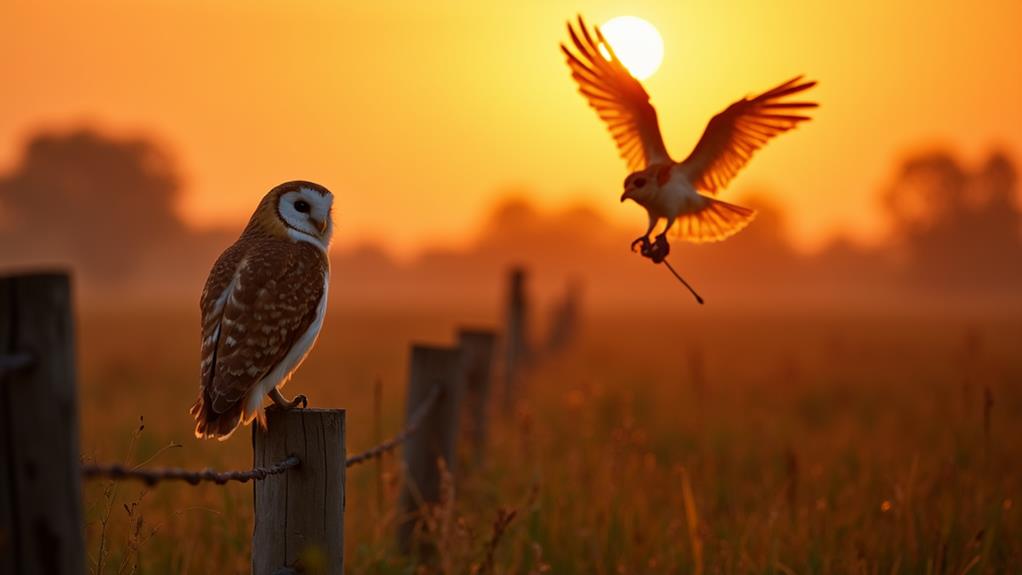
When you’re exploring the vast open spaces of Texas, you might catch a glimpse of a Barn Owl perched atop a fence post or swooping down to hunt in a field.
Barn Owls thrive in open areas with low vegetation, making Texas’ grasslands, agricultural fields, and marshes ideal habitats. These owls typically nest in tree cavities, rock crevices, or abandoned nests, often near a reliable food source.
The Barn Owl’s wing structure, characterized by long, narrow wings and a rounded wingtip, enables them to fly silently and maneuver with agility.
This unique wing structure, combined with their acute hearing and exceptional low-light vision, makes them skilled hunters. Their hunting strategies involve flying low over open areas, using their acute hearing to detect prey, and then swooping down to catch unsuspecting rodents and other small mammals.
Barn Owls are also known to hunt from a perch, scanning the surrounding area for signs of movement before taking flight. By adapting to their environment and utilizing their exceptional hunting abilities, Barn Owls have become a common sight in Texas’ open landscapes.
Great Horned Owl Characteristics
While Barn Owls have adapted to thrive in Texas’ open spaces, another owl species, the Great Horned Owl, has mastered the art of living in a variety of environments.
You can find these birds in urban parks, deserts, forests, and even tundras. The Great Horned Owl’s adaptability is one of its key Great Horned Adaptations, allowing it to occupy a wide range of ecological niches.
Their powerful talons, strong wings, and acute hearing make them effective hunters in various environments.
Great Horned Owls have a distinctive ear tuft, which isn’t actually an ear but a feather tuft. Their ears are located on the sides of their head, just like other owl species.
These birds are also known for their piercing hoots, often used for communication. In many cultures, Great Horned Owls have appeared in Great Horned Mythology as symbols of wisdom and power.
However, in some Native American cultures, they’re associated with death and are considered omens. Overall, the Great Horned Owl is an apex predator that plays a crucial role in maintaining ecological balance in its environment.
Its unique characteristics make it an interesting species to study and observe.
Eastern Screech Owl Species
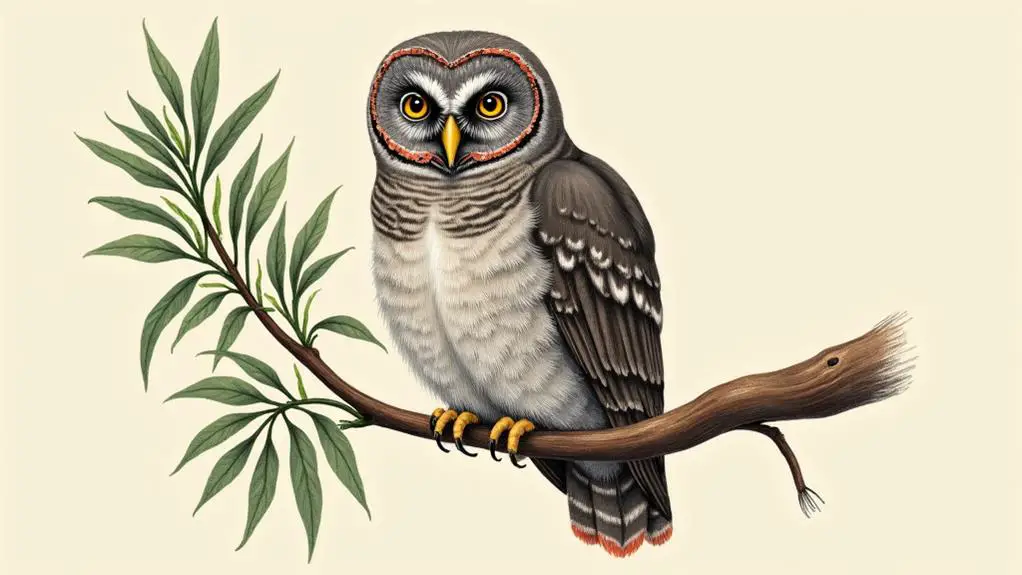
You’re now going to explore the Eastern Screech Owl, a small yet distinct owl species in Texas.
To better understand this owl, it’s essential to examine its habitat and distribution, which can range from urban parks to woodland edges and even backyards.
You’ll also discover the owl’s unique physical characteristics, such as its rounded head and mottled feathers, which play a crucial role in its ability to survive and thrive.
Habitat and Distribution
The Eastern Screech Owl inhabits a wide range of environments in Texas, from urban woodlands to rural forests.
As you explore the state, you’ll find these owls in various habitats, including forest edges and grasslands.
They’re highly adaptable, making them a common sight in many areas.
When it comes to their habitat preferences, Eastern Screech Owls tend to favor areas with:
- Mature trees: They often roost in tree cavities or nest boxes, so areas with mature trees are ideal.
- Dense undergrowth: Thick undergrowth provides cover and protection from predators.
- Access to water: Eastern Screech Owls need water for drinking and hunting, so they often live near streams, rivers, or ponds.
In Texas, you can find Eastern Screech Owls in a variety of landscapes, from the eastern forests to the central grasslands.
They’re also common in urban areas, particularly in cities with mature trees and parks.
As you explore the state, keep an eye out for these owls in their natural habitats.
Physical Characteristics
Eastern Screech Owls are relatively small, with adults typically measuring 6-10 inches in length and weighing 2-4 ounces.
As you observe these owls, you’ll notice their rounded heads, forward-facing ears, and large, round eyes that are usually yellow or orange in color. Their Owl plumage is a mix of gray, brown, and white, allowing them to blend in with their surroundings.
When examining the Owl morphology, you’ll see that Eastern Screech Owls have a flat facial disc and a short, square tail.
Their wings are broad and rounded, perfect for maneuvering through dense forests. The primary feathers are long and narrow, allowing for silent flight. Their legs and feet are short but strong, with sharp talons that help them grasp and perch.
You’ll also notice that Eastern Screech Owls have a distinctive pattern of spots or streaks on their chest and belly, which helps to distinguish them from other owl species.
Western Screech Owl Distribution
When exploring the Western Screech Owl’s distribution in Texas, you’ll find that its habitat and range play a crucial role in understanding its behavior.
You’ll discover that these owls inhabit urban and natural environments, including woodlands, parks, and backyards with trees.
As you examine their distribution, you’ll also learn about their nesting and mating habits, diet, and unique behaviors that set them apart from other owl species.
Habitat and Range
What habitats in Texas provide an ideal home for the Western Screech Owl?
When searching for these birds, you’ll typically find them in areas with dense, deciduous, and mixed deciduous-evergreen forests.
These owls prefer habitats with tall trees, especially along forest edges and woodland corridors, where they can easily hunt for insects and small vertebrates.
Some specific features of their habitats include:
- Wooded areas with dense undergrowth: Western Screech Owls use undergrowth for shelter, nesting, and protection from predators.
- Forest edges with nearby open areas: These owls like to have nearby open areas for foraging and hunting.
- Woodland corridors along rivers and streams: These corridors provide an ideal habitat for Western Screech Owls, offering a mix of trees, shrubs, and open areas along waterways.
In Texas, you can find Western Screech Owls in areas with these habitat features, particularly in the eastern and central parts of the state.
Nesting and Mating
As you delve into the world of Western Screech Owls in Texas, you’ll find that their nesting and mating habits are intricately tied to their distribution across the state.
These owls typically form long-term monogamous relationships, with some pairs staying together for many years, showcasing their remarkable owl fidelity. They often reuse the same nesting site, even after several years, further emphasizing their attachment to their territory.
During the breeding season, which typically occurs from February to April, Western Screech Owls engage in a unique owl courtship ritual.
The male’s high-pitched whistling is often followed by a series of short, descending whistles, which signals the start of the breeding process. The female responds with her own whistling, and the pair’s vocal exchange becomes more intense as they solidify their bond.
Western Screech Owls typically nest in natural cavities, such as tree holes or rock crevices, and occasionally use abandoned nests or nesting boxes.
The female lays 2-4 eggs, which she incubates for about 26 days, while the male provides food and protection. Both parents take turns caring for their young, teaching them essential survival skills before they fledge and become independent.
Diet and Behavior
Embracing the night with acute senses, Western Screech Owls in Texas primarily feed on invertebrates, with insects making up the bulk of their diet.
As you observe these birds, you’ll notice that they’ve specific food preferences that shape their hunting strategies. Insects, including beetles, moths, and grasshoppers, are their staple food.
Some key components of their diet include:
- Insects, such as ground beetles and June beetles
- Spiders and other arachnids
- Small vertebrates like lizards and frogs, occasionally caught when opportunities arise
As you delve into the world of Western Screech Owls, you’ll see that they’re skilled hunters.
They employ a “sit-and-wait” approach, perching quietly and using their acute hearing and exceptional vision to locate prey.
They’re agile flyers, swooping down on unsuspecting insects or catching them mid-air.
When hunting vertebrates, they usually use stealth, catching them off guard.
Understanding their food preferences and hunting strategies will help you better appreciate these nocturnal birds.
Burrowing Owl Conservation Status
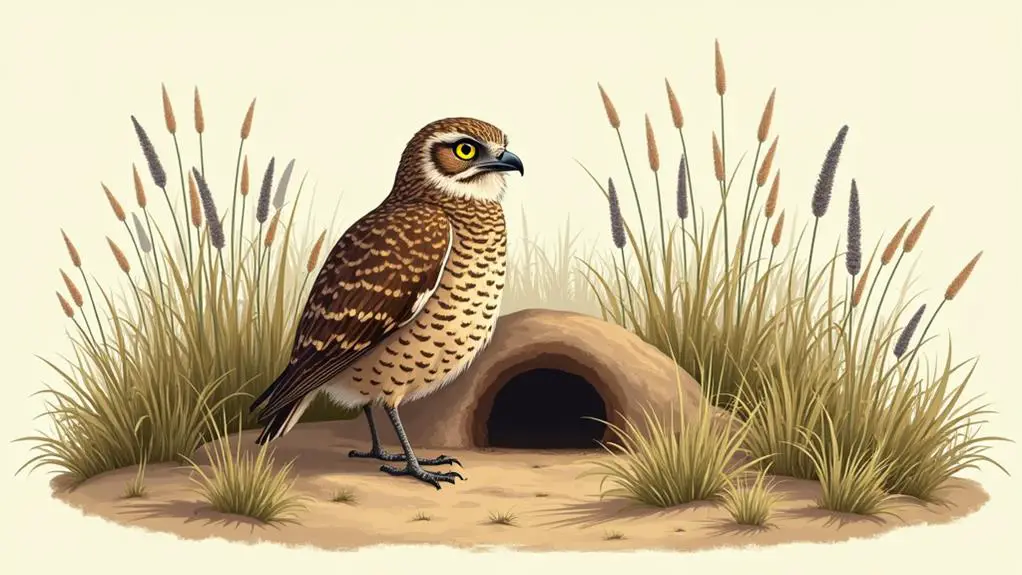
In Texas, you’ll find that the Burrowing Owl’s conservation status is a pressing concern. As their habitats are being destroyed and fragmented, their numbers are declining, making conservation efforts essential.
| Conservation Status | Reasons | Conservation Efforts |
|---|---|---|
| Vulnerable | Habitat loss, human disturbance | Burrowing owl reintroduction programs |
| Declining | Climate change, reduced prey | Creating burrowing owl sanctuaries |
| Protected | Listed under the Texas Parks and Wildlife Department’s threatened species | Habitat restoration, education and outreach |
| Regional | Varied across different regions in Texas | Collaborative efforts between organizations and landowners |
You can help by supporting organizations involved in burrowing owl conservation. These organizations work tirelessly to protect and restore habitats, as well as educate the public about the importance of conservation. By visiting burrowing owl sanctuaries and participating in conservation events, you can make a difference in the lives of these magnificent birds. Remember, every small action counts, and collective efforts can lead to significant positive change for the Burrowing Owl population in Texas.
Great Gray Owl Migration Patterns
While conservation efforts are underway to protect Texas’ owl populations, it’s also fascinating to explore the unique behaviors of these birds.
The Great Gray Owl, a rare winter visitor to Texas, exhibits intriguing migration patterns. You can track the Great Gray Owl’s migration routes, which vary depending on the region.
Typically, these owls breed in the boreal forests of Canada and Alaska, then migrate to their wintering grounds in the northern United States and southern Canada.
- Variable migration routes: Great Gray Owls don’t follow a fixed migration route, and their paths can vary significantly from year to year.
- Wintering grounds: The owls typically winter in areas with abundant small mammal populations, such as rodents and voles.
- Irruptive migration: Great Gray Owls are known to make irruptive migrations, where large numbers of birds move south in search of food, often in response to fluctuations in prey populations.
Long-eared Owl Identification Tips

When you spot a Long-eared Owl in Texas, its distinctive appearance can make identification easier, but it still requires attention to key features.
The Long-eared Owl’s ear tufts, which resemble small horns, are one of its most distinctive characteristics. These tufts are usually held upright, but can be laid back when the owl is alarmed or excited.
The owl’s facial disks, which are the flat areas around its eyes, are also an important identification feature. The facial disks are pale, with a dark border around the eyes.
You’ll also notice the Long-eared Owl’s mottled brown and gray plumage, which helps it blend in with its surroundings.
The owl’s wings are long and narrow, with a distinctive black and brown pattern. When perched, the owl’s long ears and forward-facing facial disks give it a distinctive “owl-like” appearance.
To confirm your identification, listen for the owl’s distinctive call, which sounds like a low, mournful whistle.
Short-eared Owl Breeding Habits
Short-eared Owls in Texas breed from February to August, and they typically choose open areas with low vegetation for their breeding grounds.
You’ll often find them in marshes, grasslands, and agricultural fields. During this time, you can observe their mating rituals, which involve aerial displays and vocalizations to attract a mate.
Short-eared Owl breeding habits have some key aspects:
- Territorial establishment: Short-eared Owls establish their breeding territories by flying and calling loudly to ward off potential competitors. They also use visual displays, such as wing-flapping and bowing, to reinforce their territorial claims.
- Mate selection: Once a territory is established, the male Short-eared Owl will engage in courtship behaviors to attract a female. This includes flying and calling, as well as offering food to the female.
- Breeding site selection: The female Short-eared Owl will typically choose a breeding site within the male’s territory. This site is often marked by a subtle depression in the ground or a slight elevation, providing a sense of security and protection for the nest.
Barred Owl Nesting Sites
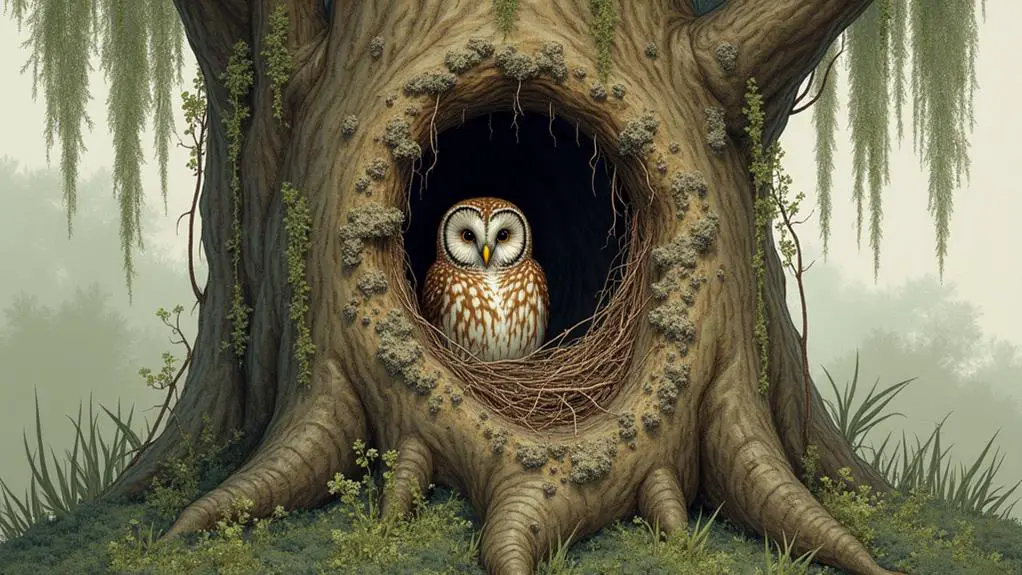
In contrast to the open areas preferred by Short-eared Owls, Barred Owls in Texas typically choose more secluded and wooded locations for their nesting sites. You’ll find them in dense forests, along rivers, or near swamps. As you explore these environments, keep in mind that Barred Owls have specific preferences when it comes to tree selection.
| Tree Characteristics | Desired Features |
|---|---|
| Canopy Cover | Dense, with a closed canopy to provide shelter from the elements |
| Tree Size | Large, with a diameter of at least 30 inches to accommodate nesting cavities |
| Branch Structure | Wide, sturdy branches that can support the weight of the owl and its nest |
| Species | Native trees like cypress, oak, or pine, which offer suitable nesting sites and protection |
When it comes to nesting strategies, Barred Owls often take over existing cavities or nests, rather than building their own. They may also use tree holes, rock crevices, or abandoned nests of other birds. By understanding these preferences, you can better locate and observe Barred Owls in their natural habitats.
FAQs: Types of Owls in Texas
Can I Keep Owls as Pets in Texas?
You’ll need to check Texas pet laws and obtain owl permits before keeping owls as pets. The Texas Parks and Wildlife Department regulates exotic pet ownership, requiring special permits and licenses for owl ownership.
How Do I Attract Owls to My Backyard?
Attracting owls to your yard requires strategic planning and patience. You’ll need to create a welcoming environment by installing owl nesting boxes and placing birdhouses in tall trees or poles, about 10-15 feet high.
Are All Owl Species in Texas Protected?
You’ll find that not all owl species are protected, but many have specific conservation status and permit requirements. In Texas, some owl species are listed as threatened or endangered, requiring special permits for handling or relocation.
Can I Feed Owls in the Wild?
While you might be tempted to feed those big round eyes, you shouldn’t feed owls in the wild. Practicing wild feeding can disrupt their natural diet and social behaviors, so follow owl etiquette and let them hunt naturally.
Do Owls Make Good Hunting Companions?
You might think owls make good hunting companions, but they’re not trained like dogs. As silent stalkers, they’re skilled nocturnal partners, but their independence and wild nature make them unreliable for hunting alongside humans.
Conclusion: White Owls in Texas
As you venture into the heart of Texas, the night skies come alive with the haunting calls of owls. From the urban backyards to the dense forests, these mysterious birds of prey rule the darkness. With their piercing gazes and silent wings, they’re a sight to behold. As you’ve discovered, Texas is home to a diverse range of owl species, each with its unique charm and characteristics. Keep exploring, and you might just catch a glimpse of these nocturnal wonders.

